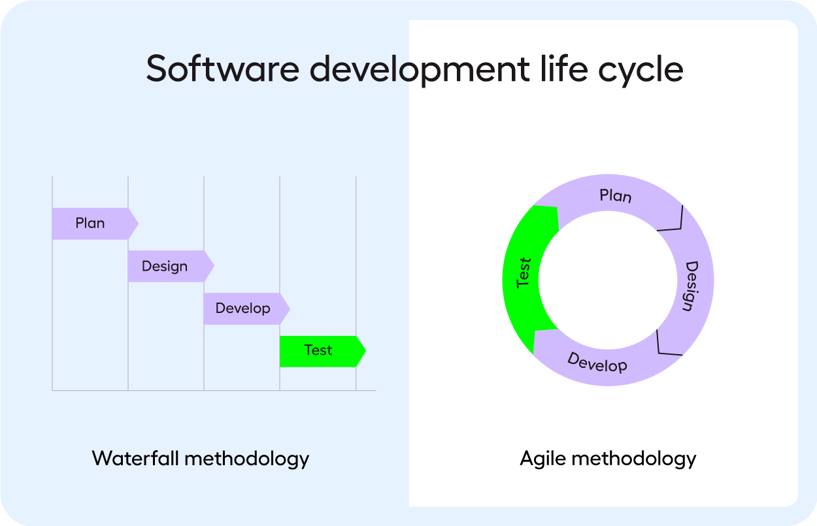How to do Agile Test Automation in the BFSI Industry
Now, more than ever, there’s a need for increased digitalization and accelerated innovation. The necessity for digital tools in the post-COVID-19 era has gone from “nice to have” to mission-critical.
In the BFSI (Banking, Financial Services, and Insurance) sector, there have been major changes in the way employees and customers interact with one another. Not only that, remote working has added even more disruption to the business.
According to a recent report by Allied Market Research, digital transformation in the BFSI market will reach $164.08 billion, globally, by 2027 at 15.4% CAGR.
As the landscape of digital capabilities and customer expectations change rapidly, new digital methods are being adopted. So what role does test automation play in all of this?
Why is agility important for BFSI?
Agile transformation helps businesses manage change and pursue emerging opportunities in any market situation. A key ingredient of this approach is agile test automation.
The BFSI industry is characterized by having complex, integrated applications and legacy systems that control and run business-critical processes. These applications are continuously evolving to meet the demands of the new digital era. In turn, every change is posing a risk to the existing functionality of business's digital ecosystems.
Bugs released into business-critical systems are extremely costly for BFSI organizations. The only way to fight off those bugs is to test and monitor the systems as frequently as possible.
Learn how Investec, a specialist bank and wealth manager, improved the quality of their releases and reduced risk by automating 95% of their test cases:
BFSI Test Automation: The Basics
Software testing in the BFSI industry is focused primarily on achieving two objectives:
- Ensure that the business-critical activities are executed as intended and that they remain protected and secured.
- Ensure that the different modules of a BFSI application are integrated properly.
The most efficient way of achieving these is through CI/CD (continuous integration, continuous development). However, some teams still test their applications manually and/or follow a traditional waterfall approach.
Recommended reading: What’s Stopping BFSI Industries from Becoming Agile?
Within this waterfall methodology, the QA team tests the software at the end of the Software Development Cycle (SDLC). The problem with this approach is that it usually results in last-minute changes or unfinished/faulty software.
An agile methodology, on the other hand, supports CI/CD by making the process more flexible and effective at speed. The tester is continuously executing tests at the same time as the developer is writing code.
With this methodology, the tester is at the core of the SDLC thanks to a continuous feedback loop with the customers, developers, and other stakeholders.

Recommended reading: How to Work with Agile Methodology in Testing for Successful Software Development
Is it then possible to do manual testing, and follow an agile methodology?
Let's put it this way. Would you drive a Ford Ranger to an F1 race? Probably not. You can still complete the race, but you know that it’s not the most efficient vehicle for the track.
Continuous delivery and agile testing go hand in hand. However, agility in testing cannot be achieved without automation.
Download the whitepaper: Continuous Testing in Agile
Automated testing allows a QA team to be agile. And agility, on the other hand, allows you to fail fast and act promptly. If the QA team uses automation, they are able to react faster whenever a bug is found in their applications.
Regression testing, for example, is the perfect candidate for automation. As software systems change or grow, so will the number of test cases and thereby the regression suite.
On top of that, for many QA teams, limited resources mean regression testing is overlooked, rushed, or down-prioritized. This creates a negative spiral of releases with bugs, poor user experiences, and unsatisfied customers.
Fortunately, due to its repetitive and predictable nature, regression testing is an ideal candidate for automation. Test automation allows the QA team to test faster and with fewer errors than they would if done manually.
If you want to learn more about how to perform regression testing for quality delivery at speed, download our free whitepaper: Achieving Agile Regression Testing.
The Benefits of Codeless Test Automation
In the BFSI sector, testers are expected to have good domain knowledge and strictly follow a set of requirements. This is due to the significance and confidential nature of the processes under test. Communication is key between all stakeholders.
Unfortunately, programming languages are only understood by a selected few. So when choosing an automation tool, it is worth looking into codeless automation.
No-code automation tools narrow the communication gap between team members. This is because everyone is able to create, share and understand automated test cases.
No-code automation in agile testing brings an array of benefits including:
-
Faster release cycles: Agile communication accelerates the team’s ability to create and deliver value by breaking down silos.
-
Improved flexibility within the organization: Collaboration allows the team to be responsive towards frequent requirement changes during the release cycles.
-
Better alignment with stakeholders: removing code from the equation means that key stakeholders can be actively involved in the QA process
-
Increased profitability: Opening the test automation process to different stakeholders will generate innovative ideas that will propel QA forward.
If you want to learn more about automation for the BFSI industry, sign up for our webinar below:

